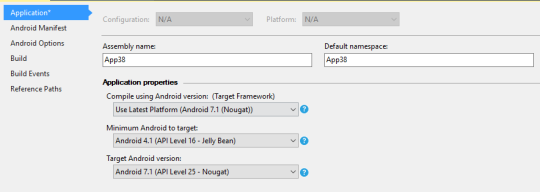It felt like just yesterday we released Cycle 8, which was packed full of good stuff like iOS 10 and Android N. I wrote a full blog post on how to prepare your machines for Cycle 8, and I figure since today we released Cycle 9 it would be a good time to refresh it!
1.) Install the latest JDK 1.8 x64 (currently 8u121)
Installing the x64 version on Windows is extremely important because it is needed for custom controls in the Android designer and also for the Xamarin.Forms Previewer to work. If you don’t have a x64 machine know that these are a few of the restrictions that may not work on your machine.
2.) Install Xamarin for Visual Studio 4.3! Do it!
Tools -> Options -> Xamarin -> Other -> Stable -> Check Now! and you will see Xamarin 4.3.0.784

If you are on VS Enterprise you may also see a few other goodies in there.
3.) Ensure Android Settings are pointing to JDK 1.8
Under Tools -> Options -> Xamarin -> Android Settings. Then close VS and re-open it.
4.) Install Android API 25 SDK and Tools
As always, it is time to update and install new SDk tools :) In Visual Studio open Tools->Android->Android SDK Manager. First thing is to tap “Deselect All” so you don’t install everything.
We will want to install the following:
- Android SDK Tools 25.2.5 (you may not see this at first, but keep updating the top SDK Tools and eventually it will show. You may have to close and open the SDK manager a few times)
- Android SDK Platform-tools 25.0.3
- Android SDK Build-tools 25.0.2
- Under Android 7.1 (API 25) install SDK Platform (you can install more if you want images too, but not required)

5.) Validate things build!
Try to create a new Android Blank App. Then right click and go to properties and Set the Compile and Target to Android 7.1 API 25:

Build should succeed and you should be good to go! Open other Android projects and give it a try.
Android (macOS)
Essentially for macOS we need to do the exact same stuff, but for macOS.
1.) Install JDK 1.8 8u121 for Mac OS X (they haven’t renamed to macOS yet)
2.) Update Xamarin Studio and Xamarin.Android (you will probably get more updates too) under Xamarin Studio -> Check for Updates -> Stable
3.) Install Latest Android SDKs under Tools -> Android/SDK Manager install the follow like the PC version above.
iOS
Time to move on to iOS. There isn’t anything else to install on the PC, but you must update a few things over on the Mac.
1.) Open the Mac App Store and install the Xcode 8.2.1 update.
This takes some serious time as it is a huge install (4.43GB) and you can always check on the progress by launching the Launchpad app.
1.1) After install launch Xcode at least once so everything registers.
2.) Update Xamarin Studio and Xamarin.iOS (you will probably get more updates too) under Xamarin Studio -> Check for Updates -> Stable. If you already updated for Android, then you are good to go.
3.) Optionally install older simulators via Xcode->Preferences->Components.
That is about it from my findings. Have fun and enjoy new iOS 10.2 and Android 7.1 development :)



